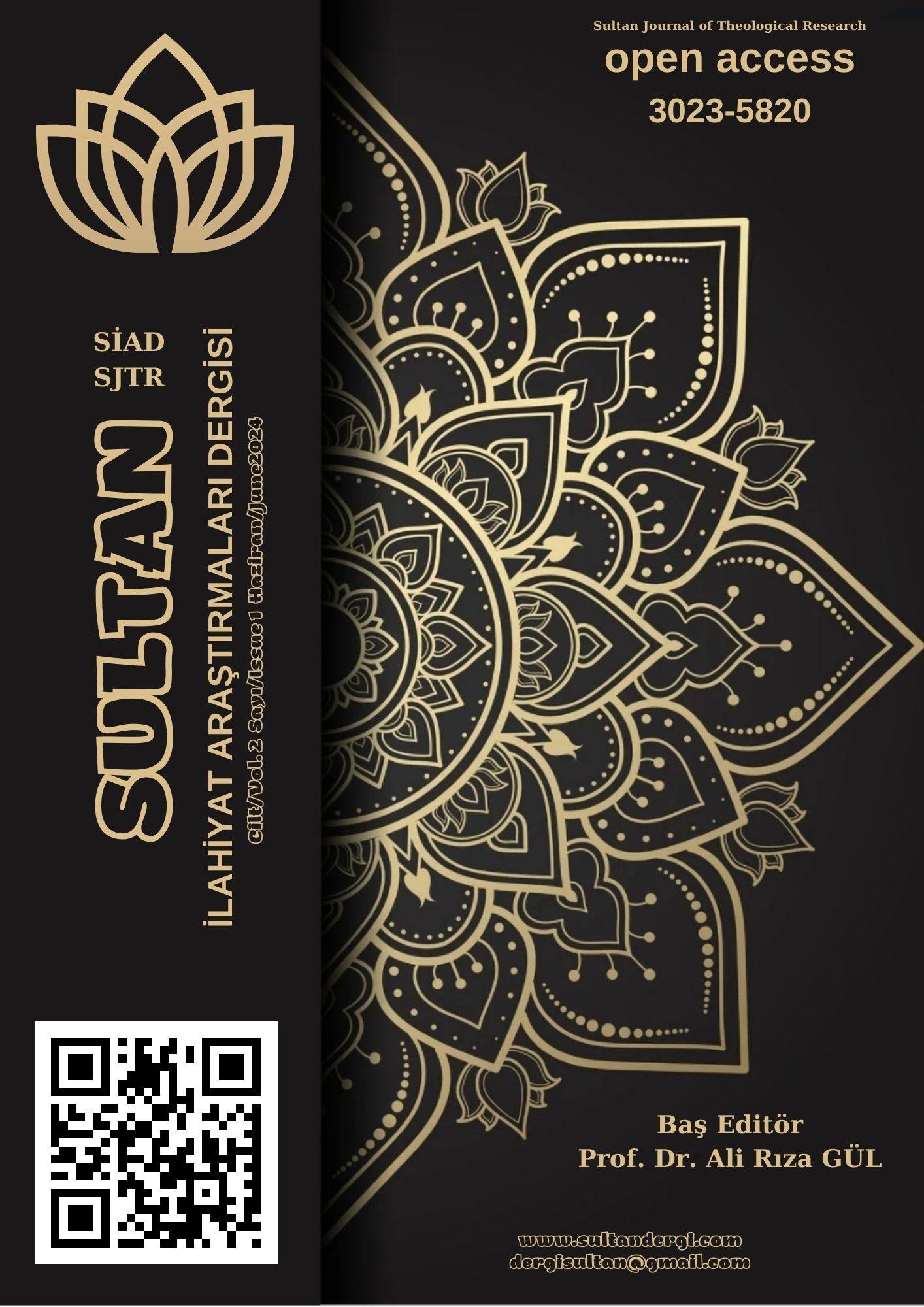An Analysis of the Eloquent Style of the Qur'an: The Example of Surah Al-Hujurat
DOI:
https://doi.org/10.5281/zenodo.12578500Keywords:
Arabic Language And rethorich, Morphology, Syntax, Hujurat Surah, Qur’an.Abstract
The belâgat, is one of the most important tools with the power to influence people and societies due to its incorporation of literary devices. Ancient texts and literary sources are filled with the most exquisite examples of the art of rhetoric. Especially, the pre-Islamic era of ignorance was a period when eloquence reached its peak, and Arabs excelled in the field of language and speech. and Arabs held authority in the realm of language and speech. The Qur'an silenced the masters of words and authorities of poetry in the era it was revealed. The magnitude of this effect can be seen in the example of the mu'allaqat al-sab'a (the seven hanging poems), the most eloquent poems that were displayed on the wall of the Kaaba. The superior eloquence and rhetoric of the Qur'an compelled the owners of these poems to take their works down from the wall. The Qur'an not only offers humanity a prescription for eternal salvation but also encompasses the highest levels of rhetorical arts. The chapters and verses of the Qur'an are filled with the most exquisite examples of these arts. Surah Al-Hujurat, with its rich literary devices, is a notable chapter in this regard. As a result of the literature review, the fact that there are almost no studies examining the surah in terms of rhetoric reveals the purpose of the study. In this study, the literary devices found in Surah Al-Hujurat are examined in light of the branches of rhetoric: “meani,” “bayan,” and “badi.” In the initial stage, definitions of the fundamental concepts of “rhetoric,” “meani,” “bayan,” and “badi'” as provided by various linguists are included. Firstly, a brief introduction about the surah is provided, summarizing the topics addressed in its verses. Then, definitions of the terms and concepts related to the rhetorical arts present in the surah are given, and these arts are analyzed with examples from the relevant verses. In this context, identifying and analyzing the rhetorical arts in the surah is an important step for correctly understanding the messages conveyed. This study serves as a resource for those who wish to conduct research on the Qur'an in general, and on Surah Al-Hujurat in particular.
References
Abbâs, Ebû Muhammed Fazl b. Hasen b. Ahmed b. es-Safûrî eş-Şâfiî. Fennu’l-belâga, İlmu’l-meânî. Ürdün: Daru’l-Furkân li’n-neşri ve’t-tevzî‘, 1997.
Atîk, Abdülaziz. İlmü’l-Meâni. Beyrut: Daru’n-Nehdati’l-Arabiyye, 1985.
Askerî, Ebû Hilâl el-Hasen b. Abdillâh b. Sehl. Kitabu’s-Sınaateyn el-Kitabe ve’ş-Şi’r. thk. Ali Muhammed el-Bicavî, Muhammed Ebu’l-Fadl İbrahim, Dımeşk: Dar-u İhyai’l-Kutubi’l-Arabiyye, 1952.
Bolelli, Nusret. Belâgat. İstanbul: İFAV Yayınları, 2015.
Bulut, Ali. Belâgat (Meânî – Beyân – Bedî). İstanbul: MÜİF Vakfı Yayınları, 2014.
Cârim, Alî b. Muhammed b. Sâlih b. Abdilfettâh b. Muhammed. el-Belâġatü’l-vâżıḥa. Beyrut: Mektebetü Dâri’l-Fecr, 2014.
Cürcânî, Ebû Bekr Abdülkâhir b. Abdurrahman. Delâilü’l-iʿ câz fî ilmi’l-meʿ ânî. thk. Abdülhamîd Hindâvî, Beyrut: Dâru’l-Kutubi’l-ʿİlmiyye, 2001.
Cürcânî, Ebü’l-Hasen Alî b. Muhammed b. Alî es-Seyyid eş-Şerîf el-Hanefî. et-Tarifât. thk. Komisyon, Beyrut: Daru’l-Kütübi’l-İlmiyye, 1983.
Dervîş, Muhyiddîn. İ‘rabu'l-Kur'âni'l-Kerîm ve beyânuh. Dımeşk: Dâru'l-Yemâme, 2011.
Dib, Muhammed Muhyiddîn. Ulumu’l-Belağa (Bediî, Beyan, Meâni). Trablus: Müesseti’l-hadiseti li’l-Kitab, 2003.
Durmuş, İsmail. “Fasl” DİA, İstanbul: TDV Yayınları, 1995.
Durmuş, İsmail. “İltifat”, DİA, İstanbul: TDV Yayınları, 2000.
Durmuş, İsmail. “Tağlib”, DİA, İstanbul: TDV Yayınları, 2010.
Durmuş, İsmail. “Kinaye”, DİA, İstanbul: TDV Yayınları, 2002.
Haşimî, es-Seyyid Ahmed b. İbrahim. Cevâhiru’l-Belâğa fi’l-Meânî ve’l-Beyân ve’l-Bedî’. thk. Yusuf Sumeylî, Beyrut: el-Mektebetü’l-Asriyye, 1999.
Hattâbî, Ebû Süleymân Hamd (Ahmed) b. Muhammed b. İbrâhîm b. Hattâb el-Büstî. Beyânü iʿcâzi’l-Ḳurʾân. thk. Muhammed Halefullah Ahmed, Muhammed Zağlûl Selam, Mısır: Daru’l-Maârif, 1976.
Işık, Emin. “Hucurât” DİA, İstanbul: TDV Yayınları, 1998.
İbn Âşûr, Ebû Abdillâh Muhammed et-Tâhir b. Muhammed b. Muhammed eş-Şâzelî b. Abdilkādir b. Muhammed. et-Taḥrîr ve’t-tenvîr. Tunus: ed-Dâru’t-Tunûsiyye li’n-Neşr, 1999.
İbn Manzûr, Ebü’l-Fazl Cemâlüddîn Muhammed b. Mükerrem b. Alî b. Ahmed el-Ensârî er-Rüveyfiî. Lisânü’l-ʿArab. Beyrut: Dârus-Sadr, 1994.
Karaman, H., Çağrıcı M., Dönmez, İ. K., Gümüş S. Kur’an Yolu Türkçe Meâl ve Tefsiri. Ankara: DİB Yayınları, 2014.
Karamollaoğlu, Fatma Serap. Kur'ân ışığında belâgat dersleri Bedi’ ilmî. İstanbul: İşaret Yayınları, 2023.
Kazvînî, Hamdullah b. Ebî Bekr b. Ahmed. el-Îzah fi Ulûmi’l-Belağa. thk. Muhammed Abdulmunim Hafacî, Beyrut: Daru’l-Ceyl, 2003.
Kurtubî, Ebû Abdillâh Muhammed b. Ahmed b. Ebî Bekr b. Ferh. el-Câmiʿ li-aḥkâmi’l-Ḳurʾân. trc. M. Beşir Eryarsoy, İstanbul, Buruç Yayınları, 2003.
Merâğî, Ahmed Mustafa. Ulûmu’l-Belağa. Beyrut: Dâru’l-Kütübi’l-İlmiyye, 1993.
Mustafa, İbrahim. el-Mu’cemu’l-Vesît. Kahire: el-Mektebetü’l-İslamiyye, 1972.
Nesefî, Ebü’l-Berekât Hâfızüddîn Abdullah b. Ahmed b. Mahmûd. Medârikü’t-Tenzîl Ve Hakāiku’t-Te’vîl. trc. Şerafettin Şenaslan, İstanbul: Ravza Yayınları, 2005.
Râzî, Ebü’l-Fazl Fahrüddîn Muhammed b. Ömer b. Hüseyn et-Taberistânî. Tefsîr-i Kebîr: Mefatîhu’l-gayb. İstanbul: Huzur Yayınevi, 2002.
Sâbûnî, Muhammed Ali. Safvetü‟t-Tefâsir. trc. Prof. Dr. Sadreddin Gümüş, Yrd. Doç. Dr. Nedim Yılmaz, İstanbul: İz Yayıncılık, 2003.
Sâfî, Mahmud. el-Cedvel fî i‘râbi'l-Kur'ân ve sarfihi ve beyânih. Dımeşk: Dâru'r-Reşîd, 1995.
Sekkâkî, Ebû Ya‘kūb Sirâcüddîn Yûsuf b. Ebî Bekr b. Muhammed b. Alî el-Hârizmî. Miftâhu’l-ʿulûm. Beyrut: Dâru’l-Kütübi’l-İlmiyye, 1987.
Sübkî, Ebû Hâmid Bahâüddîn Ahmed b. Alî b. Abdilkâfî el-Mısrî. Arûsu’l-efrâh fî şerhi telhîsi’l-miftâh. thk. Abdülhamîd Hindavî, Beyrut: Mektebetü’l-Asriyye, 2003.
Süyûtî, Ebü’l-Fazl Celâlüddîn Abdurrahmân b. Ebî Bekr b. Muhammed el-Hudayrî eş-Şâfiî. el-Câmiʿu’l-kebîr. thk. Muhtar İbrahim Hacîm, Beyrut: Dâru’l-Kutubi’l-İlmiyye, 2000.
Süyûtî, Ebü’l-Fazl Celâlüddîn Abdurrahmân b. Ebî Bekr b. Muhammed el-Hudayrî eş-Şâfiî. el-İtkân fî ‘Ulûmi’l-Kur’ân. thk. Muhtar İbrahim Hacîm, Beyrut: Dâru İbn Kesîr, 2000.
Taberî, Ebû Ca‘fer Muhammed b. Cerîr b. Yezîd el-Âmülî el-Bağdâdî. Câmiʿu’l-beyân ʿan teʾvîli âyi’l-Ḳurʾân. trc. Hasan Karakaya, Kerim Aytekin, İstanbul: Hisar Yayınevi, 1996.
Teftâzânî, Sa‘düddîn Mes‘ûd b. Fahriddîn Ömer b. Burhâniddîn Abdillâh el-Herevî el-Horâsânî. Muhtâsaru’l-Me‘âni. thk. Muhammed Muhyiddin Abdulhamid Hindavî, Kuveyt: Daru’z-Zahiriyye, 2017).
Zebîdî, Ebü’l-Feyz Muhammed el-Murtazâ b. Muhammed b. Muhammed b. Abdirrezzâk el-Bilgrâmî el-Hüseynî. Tâcü’l-ʿarûs min cevâhiri’l-Ḳāmûs. Kahire: Dâru’l-Hidâye, 1975.
Zemahşerî, Ebü’l-Kāsım Mahmûd b. Ömer b. Muhammed el-Hârizmî. el-Keşşâf. trc. Komisyon, İstanbul: Bilnet Basım Yayın, 2020.
Downloads
Published
Versions
- 2025-02-11 (2)
- 2024-06-30 (1)
How to Cite
Issue
Section
License
Copyright (c) 2024 Mahir Bayrak, Ayhan Can

This work is licensed under a Creative Commons Attribution-NonCommercial 4.0 International License.





